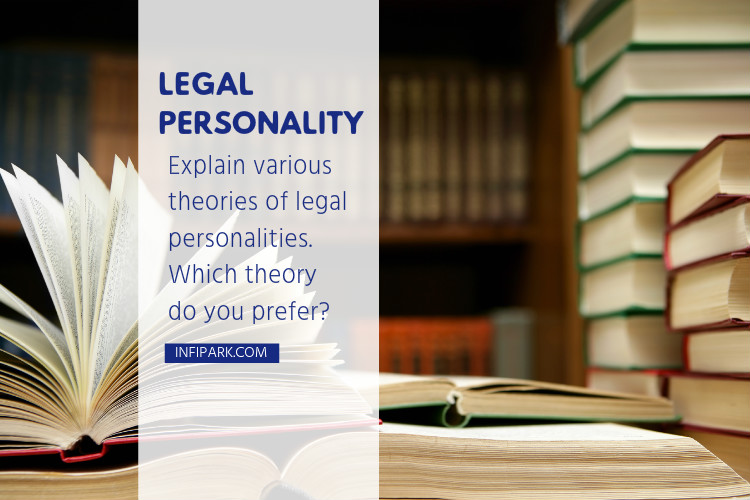Explain various theories of legal personalities. Which theory do you prefer?
OR
Enumerate various theories relating to corporate personality.
OR
Trace the difference between a legal person and a natural person.
Ans. Theories of corporate personality—There is much controversy amongst the jurists about the nature of corporate personality. Prof Wolffin an Article (1938 L.Q.R. 494) has mentioned eight theories about the corporate personality, but mainly there are five, which are as followes:
1. Purpose theory–This theory was originally propounded by German jurist Brinz and was developed in England by Barker. According to this theory, a person is applicable only to human beings, and they are the subjects of rights and duties. Juristic persons are not persons at all. Juristic persons are distinct from their human substratum, and are treated as subjectless properties or in the words of Giaus `res nulliusl. But other people owe duties towards these `subjectless properties’ without there being correlative rights, which is not improbable the critics have condemned this theory on this ground. According to Duguit the endeavour of law is to achieve social solidarity. The question is always whether a given group is pursuing a purpose which conforms with social solidarity. The idea of collective will was rejected by him but he stressed that there could be a collective purpose for a corporate personality.
This theory has been recognized in Germany but the English Courts did not approve this theory.
2. Concession Theory–The supporter of this theory is Savigny. According to the concession theory, juristic personality is a concession granted by the state. It is entirely within the discretion of the state either to recognise a juristic person or not to do so. This theory is closely akin to “fiction theory” because it asserts that there is no juristic personality apart from the creation of law. At present day there are many constitutions which have recognised a fundamental right of freedom to form association. In such a case the discretionary power of the state has been exercised by recognising the juristic persons. Collectively where cartels come into existence or many corporate entities form associations having their entities separate or get themselves amalgamated, bytcreating a new entity or being absorbed by an existing big unit.
3. Bracket theory–The exponent of this theory is Ihering. According to this theory, the juristic personality is only a symbol to facilitate the working of corporation. Only the members of the corporation are “persons” in the true sense and round them a bracket is put to indicate that they are to be treated as one unit when they have formed themselves into a corporation. It is easier to safeguard the interest of the members through corporation. For example, if there are seven members in a com-pany, the reference to all of them is not always easy and advantageous. The names of such members are made in a bracket as “A and Co.” This bracket is a corporation.
The weakness of this theory lies in the fact that it is unable to indicate when the bracket may be removed and the mask lifted for the purpose of taking note of the members constituting the corporation.
4. Realist theory—The realist theory of corporate personality has the support of Gierke, Beseler, Lasson, Bluntschi, Zitelmann, Miraglia and others on the continent and has found favour in England with eminent jurists like Pollock, Maitland and Jethrow Brown. According to this theory, the personality of the corporation is not a fictitious personality recognized by the state, but it is recognized by the laws of the state in which it is born. In other words juristic persons are real persons in the same way as human beings are.
According to this theory, a group or an association of persons has a human will of its own which is different from the individual wills of the members. The wills of the members produce a new and distinct will and will is possessed by the group of persons.
Gray observes that a corporation sole is not a fictitious or juristic person, it is simply a series of natural persons some of whose rights are different and devolve in a different way from those of natural persons in general.
5. Fiction theory—This theory was propounded by Savigny. According to him, a personality is attached to corporations, institutions and associations by legal fiction. The personality of a corporation is different from its members. There is a double fiction in the case of a corporation. Juristic personality being a fiction of law has nobody to be kicked and no soul to be damned. Savigny lays down, “The essential quality of all corporations consists in this, that the subject of the right does not exist in the individual members thereof but in the ideal whole a particular, but specially important result whereof is, that by the change of an individual member, indeed, even of all the members, the essence and unity of a corporation is not affected.”
As an incorporated person is created by the fiction of law, so the law may uplift its veil when justice requires, either in case of determina-tion of enemy character or to prevent fraud or improper character. In Daimler Co. Ltd. v. Continental Tyre Rubber Co., (1916) AC, all the shareholders of a company except one were German and the company was in the control of Germans. The House of Lords held that the com-pany was an enemy company and the decree cannot be passed in favour of the company.
Appraisal—Dr. Friedmann analyzed different theories of juristic personality and concluded that almost all of them had a political’ significance and their role in attending to the legal problems has only been rather secondary expressing their views about the theories of legal personality Dias and Hughes observed that there is no single theory which takes into account all the aspects of the problem of juristic personality. The theories that are propounded are philosophical, political or analytical. But it must be born in mind that functional basis of the law cannot be ignored. It is for this reason that English law has not committed itself to any particular theory, there is undoubtedly a greater deal of theoretical sense in each theory but it is not easy to say how much of it affects a particular decision.
“Difference between Natural person and a Corporate personality”.—When a group of persons form themselves into some corporate entity as per legal procedure prevalent for that purpose, the birth of a juristic person occurs, having legal rights and duties with distinct and separate personality from the persons who formed it. This new corporate personality can be sued and can sue others, hold and possess property, incur expenses and open bank account etc. just like a natural person. By forming themselves on to a corporation the natural persons do not lose their Fundamental Rights and they are entitled to enjoy their Fundamental Rights together with the corporate entity they have formed, but this corporate entity distinctly and separately from the members who formed it cannot claim Fundamental Rights just like natural persons. (See Bank Nationalisation of 1970). The Corporate personality may also be attrib-uted nationality and citizenship by the place of its registered office.
The lifting of veil is resorted to for ascertaining the tax liability, existence of fraud, enemy character or indulgence in activities dangerous to security morals, law and order or public policy of a particular state.
The natural person can be arrested and sent to jail but a corporation can be fines and cannot be sent to jail as it is not physically possible, though after piercing the veil, the persons behind the corporations may be arrested and sent to jail.
The personality given to a corporation is given by the law and if the birth of such an entity happens to be illegal it can be dissolved by the law, but an illegitimate child is allowed to exist having some reduced rights.








